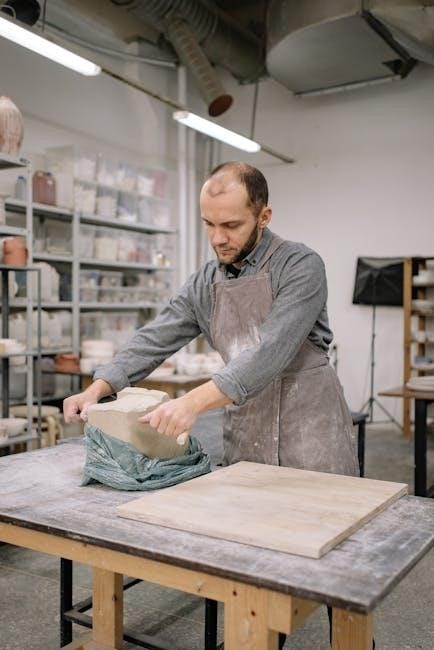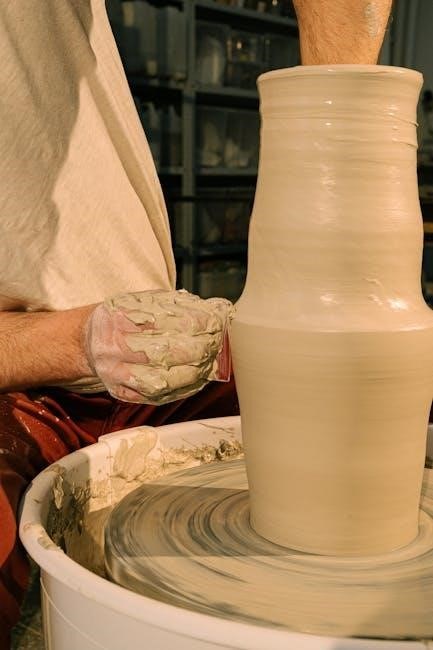The thermal expansion molding process is a cost-effective method for fabricating lightweight aircraft composite structures. It utilizes rubber tooling that expands thermally to apply pressure during curing.
Overview of Thermal Expansion Molding
Thermal expansion molding is a versatile and cost-efficient manufacturing technique primarily used for producing lightweight aircraft composite structures. The process leverages the thermal expansion of rubber tooling to generate the necessary pressure for curing composite materials. In its simplest form‚ solid rubber blocks expand when heated within a closed mold box‚ applying uniform pressure. For more precise control‚ hollow rubber blocks can be pressurized externally. This method is particularly effective for fabricating complex geometries due to its adaptability and low tooling costs. It has become a preferred choice in aerospace manufacturing for creating high-performance‚ fiber-reinforced composite components with minimal material waste and reduced production time.
Importance of Thermal Expansion in Aerospace Engineering
Thermal expansion plays a critical role in aerospace engineering‚ particularly in the design and manufacturing of aircraft composite structures. The mismatch in thermal expansion coefficients between different materials can lead to structural stress‚ delamination‚ and failure under varying temperature conditions. This is especially significant in aerospace‚ where components are exposed to extreme temperature fluctuations during flight. Managing thermal expansion ensures the integrity and durability of composite parts‚ preventing potential failures. The thermal expansion molding process addresses this challenge by utilizing rubber tooling that expands thermally to apply uniform pressure‚ ensuring proper curing and minimizing residual stresses in the final product. This approach enhances the reliability and performance of aircraft composites.

Key Components and Materials
The process relies on rubber tooling‚ including solid and hollow rubber blocks‚ and fiber-reinforced-resin composites. These materials enable thermal expansion and uniform pressure application during curing.
Materials Used in Thermal Expansion Molding
The primary materials in thermal expansion molding include rubber tooling‚ such as solid and hollow rubber blocks‚ which expand when heated to apply pressure. Fiber-reinforced-resin composites are also central‚ combining high-strength fibers with durable resins. These materials are chosen for their ability to withstand thermal stress and ensure uniform pressure distribution during the curing process. The rubber tooling is typically silicone-based‚ offering flexibility and thermal stability‚ while the composites provide the structural integrity needed for aircraft applications. This combination enables the production of lightweight‚ high-performance components‚ making the process cost-effective and efficient for aerospace manufacturing.
Role of Rubber Tooling in the Process
Rubber tooling plays a pivotal role in thermal expansion molding‚ as it provides the necessary pressure during the curing process. Solid or hollow rubber blocks are heated‚ causing them to expand and apply uniform pressure to the composite material within the mold. This self-pressurization eliminates the need for external pressure sources‚ simplifying the process. Rubber tooling is durable‚ reusable‚ and capable of withstanding repeated thermal cycles without degradation. Its flexibility allows for the production of complex geometries‚ making it ideal for aircraft composite structures. The use of rubber tooling ensures cost-effectiveness and efficiency‚ enabling the fabrication of high-quality‚ lightweight components essential for aerospace applications.

Process Mechanics and Tooling Development
The process relies on thermally expanding rubber tooling within a mold to apply pressure‚ ensuring efficient and cost-effective fabrication of aircraft composite structures.
Basic Principles of Thermal Expansion Molding
Thermal expansion molding operates on the principle of using heat to expand rubber tooling‚ which applies pressure within a closed mold. This process leverages the physical properties of rubber compounds‚ which expand when exposed to elevated temperatures. The tooling consists of rubber blocks placed inside a hard mold box. As heat is applied‚ the rubber expands‚ creating the necessary pressure to shape and cure composite materials. This method is efficient for fabricating lightweight aircraft structures‚ as it eliminates the need for complex or expensive pressurization systems. The simplicity of the process‚ combined with its ability to produce uniform pressure‚ makes it ideal for manufacturing high-performance composite components.
Pressure Control Mechanisms in the Process
Pressure control in thermal expansion molding is achieved through the strategic use of rubber tooling. Solid rubber blocks expand thermally within a closed mold box‚ generating internal pressure. For enhanced control‚ hollow rubber blocks can be pressurized externally‚ allowing precise pressure application during the curing process. This dual approach ensures consistent pressure distribution across the composite material‚ minimizing defects; The process leverages the predictable expansion behavior of rubber‚ enabling precise molding without complex machinery. This mechanism is critical for achieving uniform consolidation and high-quality aircraft composite structures‚ making it a reliable method for aerospace manufacturing applications. Pressure control is essential for optimal results.

Advantages and Challenges
The thermal expansion molding process offers cost-effectiveness and versatility for aircraft composites but faces challenges like material limitations and the need for precise pressure control during curing.
Benefits of Thermal Expansion Molding for Aircraft Composites
Thermal expansion molding is a cost-effective and versatile method for producing high-quality aircraft composite structures. It leverages the thermal expansion of rubber tooling to apply uniform pressure during curing‚ ensuring lightweight and durable components. This process minimizes material waste and enables the fabrication of complex geometries‚ making it ideal for aerospace applications. The resulting structures exhibit excellent strength-to-weight ratios‚ which are critical for improving fuel efficiency and overall aircraft performance. Additionally‚ the process supports sustainable manufacturing practices by reducing energy consumption and material scrap‚ making it a valuable technique for modern aerospace engineering.
Challenges and Limitations of the Process
Despite its benefits‚ the thermal expansion molding process presents several challenges. Achieving precise control over thermal expansion to maintain uniform pressure during curing can be difficult. The durability of rubber tooling may degrade over multiple cycles‚ requiring frequent replacements. Additionally‚ the process may struggle with complex geometries or large-scale components‚ limiting its scalability. Material compatibility issues can also arise‚ particularly with high-performance composites‚ potentially leading to delamination or structural weaknesses. Furthermore‚ the process requires careful synchronization of heating and cooling cycles to avoid defects‚ adding complexity to manufacturing workflows. These limitations highlight the need for refined techniques and materials to optimize the process for advanced aerospace applications.

Applications and Future Trends
The thermal expansion molding process is widely applied in fabricating lightweight aircraft composite structures‚ offering cost-effective solutions for aerospace manufacturing. Future trends include advancements in material science and automation to enhance process efficiency and scalability.
Use of Thermal Expansion Molding in Aircraft Composite Structures
Thermal expansion molding is extensively utilized in fabricating aircraft composite structures‚ such as ribs‚ skins‚ and other complex components. The process leverages the thermal expansion of rubber tooling to apply uniform pressure during the curing of fiber-reinforced resin composites. This method is particularly effective for producing lightweight and durable aircraft parts‚ ensuring dimensional accuracy and structural integrity. By eliminating the need for high-cost tooling and complex machinery‚ thermal expansion molding offers a cost-efficient solution for manufacturing advanced aerospace composites. Its versatility and efficiency make it a critical technique in modern aircraft production‚ enabling the creation of high-performance‚ lightweight components essential for aerospace applications.
Future Developments in Thermal Expansion Molding Technology
Future advancements in thermal expansion molding technology are expected to focus on improving efficiency‚ sustainability‚ and material performance. Researchers are exploring the development of advanced rubber compounds with enhanced thermal stability and durability. Additionally‚ the integration of automation and smart tooling systems could optimize pressure control and curing processes. Innovations in material science may lead to the creation of eco-friendly rubber and resin systems‚ reducing environmental impact. Furthermore‚ advancements in process monitoring and simulation tools will enable real-time tracking of thermal expansion and curing‚ ensuring higher precision and consistency. These developments aim to expand the application of thermal expansion molding in next-generation aircraft composite manufacturing.

Case Study and Conclusion
A case study by Lockheed-Georgia demonstrated successful implementation of thermal expansion molding for aircraft structures‚ highlighting cost reductions and improved product quality through this innovative method.
Case Study: Successful Implementation of Thermal Expansion Molding
A case study by Lockheed-Georgia Co. demonstrated the successful application of thermal expansion molding for aircraft composite structures. The process utilized rubber tooling that expanded thermally to apply pressure during curing‚ ensuring high-quality components. This method was particularly effective for complex geometries‚ such as the RAPM-002 rib configuration‚ showcasing its versatility. The implementation highlighted significant cost savings and improved production efficiency compared to traditional methods. The study also emphasized the importance of material selection and precise control of thermal expansion to achieve desired structural integrity. This real-world application validated the process’s potential for producing lightweight‚ durable aircraft components‚ making it a valuable technique in aerospace manufacturing.

Thermal expansion molding has emerged as a pivotal technique in modern aerospace manufacturing‚ offering a cost-effective and efficient method for producing high-quality aircraft composite structures. By leveraging the thermal expansion of rubber tooling‚ this process ensures precise pressure control during curing‚ resulting in lightweight and durable components. Its ability to handle complex geometries and reduce production costs makes it a valuable asset in the industry. As demonstrated in successful implementations‚ such as the RAPM-002 rib configuration‚ thermal expansion molding is not only enhancing manufacturing efficiency but also contributing to the advancement of composite materials in aerospace engineering‚ solidifying its role in future innovations.
